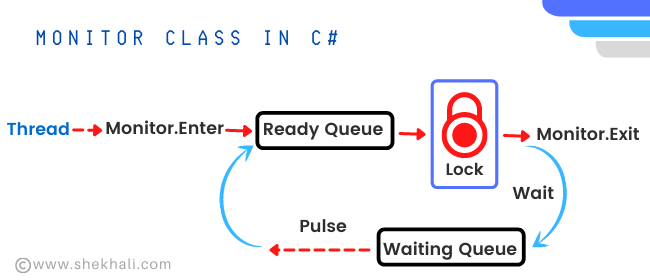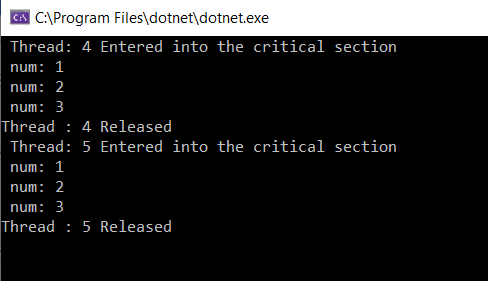
Table of Contents
- 1 What Is Monitor Class In C#?
- 2 Difference between Lock and Monitor in C#
- 3 FAQs
- 3.1 Q: What is the C# Monitor class?
- 3.2 Q: Are there any alternatives to the Monitor class for thread synchronization?
- 3.3 Q: What happens if a thread forgets to release the lock acquired with the Monitor class?
- 3.4 Q: Is the Monitor class limited to managing synchronization for only shared variables?
- 3.5 Q: Are monitors better than semaphores?
- 3.6 When should we use the monitor wait method?
- 4 Conclusion
What Is Monitor Class In C#?
C# Monitor: The Monitor class in C# provides a wait-based synchronization mechanism that allows only one thread to access a critical section of code at a time to avoid the race condition.
All the other threads have to wait and halt the execution until the locked object is released.
The Monitor.Enter method is used to acquire an exclusive lock on the object whereas Monitor.Exit method is used to release the locked object.
In order to use the Monitor class in a multithreading , we first need to import the System.Threading namespace.

C# Monitor Syntax
The following is the syntax to declare monitor class in C#
static object _lock = new object();
// Lock object
Monitor.Enter(_lock);
try
{
// Critical piece of code
}
finally
{
// Releasing object
Monitor.Exit(_lock);
}Example: C# Monitor Class in Multithreading
Following is the example of the Monitor class in C#
using System;
using System.Threading;
namespace MontitorExample
{
class Program
{
static object _lock = new object();
public static void PrintNumber()
{
// Lock object
Monitor.Enter(_lock);
try
{
// Critical piece of code
int threadId = Thread.CurrentThread.ManagedThreadId;
Console.WriteLine($" Thread: {threadId} Entered into the critical section ");
for (int num = 1; num <= 3; num ++)
{
Console.WriteLine($" num: {num}");
//Pausing the thread execution for 2 seconds
Thread.Sleep(TimeSpan.FromSeconds(2));
}
}
catch (SynchronizationLockException exception)
{
Console.WriteLine(exception.Message);
}
finally
{
// Releasing object
Monitor.Exit(_lock);
Console.WriteLine($"Thread : {Thread.CurrentThread.ManagedThreadId} Released");
}
}
static void Main(string[] args)
{
// Creating threads
Thread thread1 = new Thread(PrintNumber);
Thread thread2 = new Thread(PrintNumber);
// Executing the threads
thread1.Start();
thread2.Start();
Console.ReadLine();
}
}
}
Let’s run the above program to see the result.

Methods of the Monitor class
The Monitor class is a static class which contains the following methods:
-
-
- Monitor.Enter
- Monitor.TryEnter
- Monitor.Exit
- Monitor.Pulse
- Monitor.PulseAll
- Monitor.Wait
-
Monitor.Enter, Monitor.TryEnter : These methods are used to acquire an exclusive lock on the object, which allows only one thread to access the critical section of code at a time.
Monitor.Pulse, Monitor.PulseAll : A thread sends the signal to one or multiple threads in the waiting queue that the state of the locked object has been changed. So, that they can proceed with the further process.
Monitor.Wait(): This method is used to release the locked object after getting the Pulse notification to allow other threads to lock and access the object.
The calling threads wait in the waiting queue while the other thread is allowed to access the object until it gets the pulse notification.
Note: Wait() method must execute before the Pulse or PulseAll method to get the pulse notification.
Monitor.Exit: This method is used to release the locked object, and it is always declared inside finally block.
Difference between Lock and Monitor in C#
In C#, Both the Lock and Monitor class are basically used to ensure that only one thread can access a particular section of code at a time.
The following are the basic differences between both classes:
-
- A lock statement is a short form of the Monitor class which internally wraps the methods Monitor.Enter and Monitor.Exit with an additional try/finally block, to perform the thread-safe operation, whereas in the case of Monitor class, we have to declare try and finally block explicitly to release the locked object.
-
- Apart from the synchronization mechanism, the Monitor class provides some useful methods like Wait(), Pulse(), and PulseAll() for the signaling mechanism between the threads. However, the lock doesn’t support the signaling mechanism.
- The monitor is a static class that can’t be instantiated.
FAQs
Here are some frequently asked questions (FAQs) about the C# Monitor class and its usage in managing thread synchronization:
Q: What is the C# Monitor class?
The C# Monitor class is a mechanism for thread synchronization that allows exclusive access to shared resources. It helps prevent race conditions and ensures safe concurrent access to critical sections of code.
Q: Are there any alternatives to the Monitor class for thread synchronization?
Yes, C# provides other synchronization mechanisms, such as Mutex, Semaphore, and ManualResetEvent, which can be used based on the specific synchronization requirements of the application.
Q: What happens if a thread forgets to release the lock acquired with the Monitor class?
If a thread forgets to release the lock, it can cause deadlock, where all threads waiting for the lock remain stuck indefinitely. Proper care should be taken to ensure the lock is always released after use.
No, the Monitor class can be used for synchronization in any critical section of code that needs exclusive access by multiple threads, not just limited to shared variables.
Q: Are monitors better than semaphores?
Monitors and semaphores are different synchronization mechanisms, and neither is inherently better than the other.
The choice between monitors and semaphores depends on the specific requirements of the multi-threaded application. Monitors are suitable for managing exclusive access to shared resources within the same process, while semaphores are useful for more complex synchronization scenarios involving multiple processes.
Each has its strengths and should be selected based on the specific needs of the application.
When should we use the monitor wait method?
The Monitor.Wait() execute before the Pulse or PulseAll methods, It is used to block a process’s execution and to release the locked object after getting the Pulse notification to allow other threads to lock and access the object.
The Monitor.Wait() method is an overloaded method that can have a timeout parameter to make sure that If the specified time-out interval elapses, the current thread enters the ready queue.
Conclusion
In C#, The Lock and Monitor classes are generally used for synchronization purposes in a multithreading environment.
They allow only one thread to access a critical section of code at a time.
The only major difference between both of them is that the Monitor class provides more control over synchronization by using the signaling mechanism.
Thank you for taking the time to read the blog, if you find it interesting, please like, comment, and share it with others.
Articles to Check Out
-
- C# Lock vs Mutex
- C# 10 New features with examples | What’s new in C# 10?
- C# Abstract class Vs Interface
- C# Array vs List: When should you use an array or a List?
- Generic Delegates in C# With Examples
- IEnumerable Interface in C# with examples
- Constructors in C# with Examples
- C# Enum | How to Use enumeration type in C#?
- Properties In C# with examples
- Multithreading in C#
- IEnumerable Interface in C# with examples
- C# List Class With Examples
- C# Monitor class in multithreading
- C# Struct vs Class
- C# Dictionary with Examples
- C# 12 New Features in 2025: What’s New with .NET 8 - April 11, 2025
- Difference Between WCF and Web API with Examples: A Comprehensive Guide - March 27, 2025
- PUT vs PATCH vs POST in REST API: Key Differences Explained With Examples - March 23, 2025